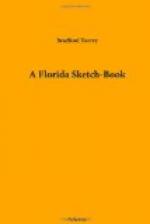In the lane, after skirting some pleasant woods, which I meant to visit again, but found no opportunity, I was suddenly assaulted by a pair of brown thrashers, half beside themselves after their manner because of my approach to their nest. How close my approach was I cannot say; but it must be confessed that I played upon their fears to the utmost of my ability, wishing to see as many of their neighbors as the disturbance would bring together. Several other thrashers, a catbird, and two house wrens appeared (all these, since “blood is thicker than water,” may have felt some special cousinly solicitude, for aught I know), with a ruby-crowned kinglet and a field sparrow.
In the valley, near a little pond, as I came out into the Meridian road, a solitary vireo was singing, in the very spot where one had been heard six days before. Was it the same bird? I asked myself. And was it settled for the summer? Such an explanation seemed the more likely because I had found no solitary vireo anywhere else about the city, though the species had been common earlier in the season in eastern and southern Florida, where I had seen my last one—at New Smyrna—March 26.
At this same dip in the Meridian road, on a previous visit, I had experienced one of the pleasantest of my Tallahassee sensations. The morning was one of those when every bird is in tune. By the road side I had just passed Carolina wrens, house wrens, a chipper, a field sparrow, two thrashers, an abundance of chewinks, two orchard orioles, several tanagers, a flock of quail, and mocking-birds and cardinals uncounted. In a pine wood near by, a wood pewee, a pine warbler, a yellow-throated warbler, and a pine-wood sparrow were singing—a most peculiarly select and modest chorus. Just at the lowest point in the valley I stopped to listen to a song which I did not recognize, but which, by and by, I settled upon as probably the work of a freakish prairie warbler. At that moment, as if to confirm my conjecture,—which in the retrospect becomes almost ridiculous,—a prairie warbler hopped into sight on an outer twig of the water-oak out of which the music had proceeded. Still something said, “Are you sure?” and I stepped inside the fence. There on the ground were two or three white-crowned sparrows, and in an instant the truth of the case flashed upon me. I remembered the saying of a friend, that the song of the white-crown had reminded him of the vesper sparrow and the black-throated green warbler. That was my bird; and I listened again, though I could no longer be said to feel in doubt. A long time I waited. Again and again the birds sang, and at last I discovered one of them perched at the top of the oak, tossing back his head and warbling —a white-crowned sparrow: the one regular Massachusetts migrant which I had often seen, but had never heard utter a sound.




